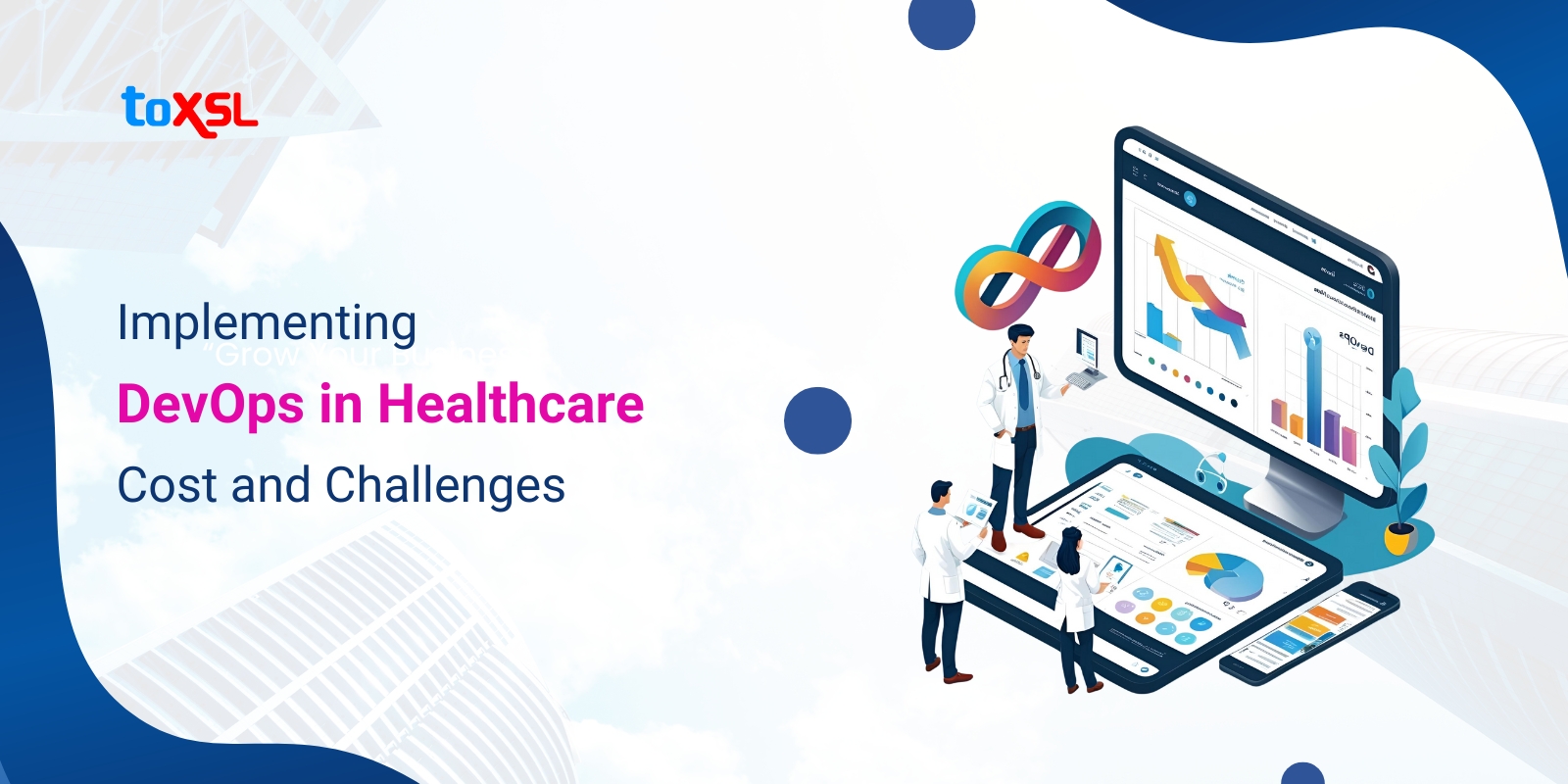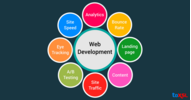- Aug 08, 2025
Share this post on:

According to Credence Research, the DevOps market will generate $35.1 billion by 2030. Today, healthcare providers incorporate DevOps in healthcare to make data accessible and secure. Healthcare DevOps enhances software excellence, speed to market, and seamless communication between operations and development teams. DevOps helps healthcare organizations enhance efficiency, streamline processes, and deliver high-quality solutions. It is a combination of software development and IT operations. The whole idea behind DevOps is to focus on collaboration, communication, and integration between the development process and IT operations.
Key Takeaway
- Market Growth: DevOps in healthcare is projected to reach $35.1B by 2030.
- Core Benefits: Faster releases, improved system reliability, and stronger security compliance (HIPAA, GDPR).
- Implementation: Start with assessment → set goals → build cross-functional teams → automate → scale.
- Cost Range: $10,000–$100,000 depending on scope, tools, and legacy systems.
- Challenges: Legacy systems, regulatory hurdles, cultural resistance, and the high cost of downtime.
- Best Practice: Start small, integrate security early, and align DevOps goals with healthcare outcomes.
How to Implement DevOps in Healthcare
Implementing DevOps in healthcare requires a careful, staged approach that aligns with the industry's strict regulatory requirements, data sensitivity, and often legacy infrastructure. Here's a practical roadmap for implementation:
Step 1: Assess Your Current State
Before implementing DevOps, evaluate your existing:
Infrastructure and architecture (cloud, on-prem, hybrid?)
Development and operations workflows
Security and compliance posture
Legacy systems and integrations
Organizational culture and team structures
Tip: Run a DevOps maturity assessment specific to healthcare compliance (HIPAA, GDPR, etc.)
Step 2: Define Clear Goals and KPIs
Set realistic, measurable goals for your DevOps transformation. For example:
Reduce release time from months to weeks
Achieve 90%+ deployment success rate
Increase automated test coverage to 80%
Reduce mean time to recovery (MTTR)
Align these goals with healthcare outcomes like system reliability, clinician efficiency, and patient safety.
Step 3: Build a Cross-Functional DevOps Team
DevOps is not a tools-only solution—it’s a culture. Form a team that includes:
Developers
System Admins / Ops Engineers
Security experts (DevSecOps)
QA/Test automation engineers
Compliance officers
Important: Security and compliance roles must be integrated from Day 1.
Step 4: Choose the Right DevOps Tools
Select tools that are compliant, scalable, and integratable with healthcare systems.
Suggested Stack:
Area Tools
CI/CD Jenkins, GitLab CI, Azure DevOps
Containerization Docker
Orchestration Kubernetes
IaC Terraform, Ansible
Monitoring Prometheus, Grafana
Security & Compliance Snyk, HashiCorp Vault, AWS Inspector
Ensure all tools support audit trails, encryption, and role-based access control (RBAC).
Step 5: Automate Infrastructure (IaC)
Use Infrastructure as Code (IaC) to provision and manage infrastructure consistently and securely.
Define environments using code (YAML, HCL)
Use version control for infra code
Automate deployments using pipelines
Example: Use Terraform to deploy HIPAA-compliant cloud infrastructure on AWS.
Step 6: Implement CI/CD Pipelines
Set up Continuous Integration and Continuous Delivery (CI/CD) pipelines:
CI: Automatically build and test code when changes are committed.
CD: Automatically deploy code to staging/production with approvals.
Key Healthcare Considerations:
Automate static code analysis and security scans
Include compliance checks (HIPAA logging, access audits)
Use “blue-green” or “canary” deployments to avoid service disruption
Step 7: Integrate Security – DevSecOps
Security in healthcare DevOps must be proactive and continuous.
Implement code scanning tools (Snyk, SonarQube)
Automate vulnerability assessments
Encrypt all data in transit and at rest
Use container security tools (Aqua, Twistlock)
Ensure access control via OAuth, SSO, RBAC
Tip: Use policy-as-code tools (e.g., OPA/Gatekeeper) to enforce HIPAA policies in pipelines.
Step 8: Monitor Everything
Set up real-time monitoring and alerting for:
Application performance (APM)
Server/resource usage
User activity (for auditing)
Anomalies or security breaches
Tools: Prometheus, ELK Stack, Datadog
Ensure logs are immutable and stored securely for audits.
Step 9: Train Teams and Promote a DevOps Culture
A successful DevOps implementation depends on people, not just tools.
Conduct workshops on DevOps practices and tools
Foster collaboration between Dev, Ops, and Security
Encourage shared responsibility for production issues
Celebrate quick recoveries, not just successful deployments
Step 10: Start Small, Then Scale
Begin with a non-critical application or department to test your DevOps model. Once stable:
Expand to mission-critical systems (e.g., EHR, telehealth)
Standardize your DevOps patterns across teams
Continuously improve based on metrics and feedback
DevOps in Healthcare: Cost
Integrating DevOps in healthcare is a strategic move that can significantly improve software delivery speed, operational efficiency, and patient care quality. In general, the cost to integrate DevOps in Healthcare ranges between $10,000 $100,000. However, understanding the cost implications is crucial for healthcare organizations considering this transformation.
Key Cost Factors in DevOps Integration for Healthcare
Development Team: The initial phase involves uniting development, operations, and clinical teams around a common mission and creating a tailored DevOps strategy. This requires investment in planning, stakeholder workshops, and possibly consulting services to assess existing processes and define workflows aligned with DevOps best practices. While this phase demands upfront time and resources, it sets the foundation for cost savings later.
Infrastructure and Tooling: DevOps relies heavily on automation tools for continuous integration, continuous deployment (CI/CD), containerization, and infrastructure provisioning. Costs include licenses or subscriptions for tools like Jenkins, Terraform, Ansible, and cloud services (AWS, Google Cloud, Azure). Efficient cloud configuration is critical; misconfigured cloud resources can lead to unnecessary expenses. Expert auditing and optimization can reduce cloud costs by up to 40% as seen in real-world cases.
Continuous Delivery Pipeline Setup: Building automated pipelines for code integration, testing, and deployment requires skilled DevOps engineers and time. Automation reduces manual work and operational overhead, lowering long-term costs. However, initial setup involves investment in scripting, testing frameworks, and integration with existing healthcare applications.
Security and Compliance (DevSecOps): Healthcare software must comply with stringent regulations like HIPAA, requiring embedded security throughout development and deployment. Implementing DevSecOps practices means additional cost for vulnerability scanning tools, access controls, and continuous monitoring. These investments are essential to avoid costly data breaches and compliance penalties.
Training and Change Management: Transitioning to DevOps culture involves training IT, clinical, and compliance teams. This includes learning new tools, processes, and collaboration methods. While training adds to upfront costs, it improves productivity and reduces errors over time.
Legacy System Modernization: Many healthcare providers operate legacy systems that are costly to maintain and difficult to integrate with modern DevOps pipelines. Gradual modernization—such as containerizing services or migrating to cloud platforms—requires careful planning and phased investment to minimize risk and downtime.
Challenges of Implementing DevOps in Healthcare
While the benefits are compelling, healthcare organizations face several unique challenges when adopting DevOps:
1. Legacy Systems and Technical Debt
Many healthcare providers rely on legacy systems that are difficult to integrate with modern DevOps tools. Replacing or modernizing these systems is often costly, risky, and time-consuming. Gradual migration—such as containerizing legacy applications or decoupling services—can help minimize disruption.
2. Regulatory and Compliance Complexity
Healthcare is one of the most regulated industries. Ensuring compliance with laws like HIPAA, GDPR, and local regulations requires meticulous documentation, audit trails, and security controls. DevOps teams must embed compliance checks into every stage of the development and deployment process.
3. Data Security and Privacy Concerns
The risk of data breaches, ransomware attacks, and unauthorized access is ever-present. Healthcare organizations must implement robust encryption, access controls, and continuous monitoring. Any lapse can lead to severe legal, financial, and reputational consequences.
4. Cultural Resistance and Skill Gaps
DevOps represents a significant cultural shift, requiring collaboration, transparency, and shared responsibility. Resistance from staff accustomed to traditional silos, as well as a shortage of DevOps expertise, can impede adoption. Ongoing training, leadership support, and clear communication are critical to overcoming these barriers.
5. Integration with Specialized Hardware
Healthcare environments often include specialized hardware (e.g., medical devices, diagnostic equipment) that may not support modern DevOps practices. Ensuring compatibility, automating firmware updates, and maintaining device security add layers of complexity.
6. High Stakes of System Downtime
In healthcare, even minor system outages can delay treatments, disrupt access to patient records, or compromise patient safety. DevOps pipelines must include real-time monitoring, automated recovery, and safe rollback mechanisms to minimize the risk of service disruptions.
7. Resource Management and Cost Control
Fluctuating demand—such as patient surges during emergencies—requires dynamic resource allocation. Without careful planning, organizations may overprovision (wasting money) or underprovision (slowing critical systems). Autoscaling and usage monitoring are essential to maintain performance and control costs.
8. Overambitious or Unstructured Adoption
Some organizations attempt to implement DevOps too quickly or without a clear strategy, leading to confusion, burnout, and failed initiatives. The best approach is to start with small, low-risk projects, refine processes, and scale gradually.
Summary
Incorporating DevOps in healthcare can help businesses build, manage, and deliver technology. DevOps helps reduce downtime during peak hospital hours, leading to safer and faster software updates. Further, DevOps in healthcare helps healthcare teams to respond in a better way while meeting high standards for security. ToXSL Technologies is a leading DevOps development company, helping businesses develop solutions that meet the unique needs of an organization.
So, if you are in the healthcare industry, incorporating DevOps can help you improve your business. Invest today and simplify your healthcare business.
FAQs
1: Why is DevOps important in healthcare?
DevOps enables faster, more reliable software updates while ensuring system stability, compliance, and data security. In healthcare, where delays or errors can impact patient outcomes, DevOps helps teams build, test, and deploy solutions efficiently—improving clinician workflows, reducing downtime, and enhancing the overall quality of digital healthcare services.
2: Is DevOps HIPAA-compliant?
DevOps can fully support HIPAA compliance when implemented with secure coding practices, audit trails, encrypted data handling, and role-based access controls. By integrating compliance checks into CI/CD pipelines and using tools like Vault or policy-as-code frameworks, healthcare organizations can maintain continuous compliance across all development and operational activities.
3: How long does it take to implement DevOps in a healthcare organization?
A basic DevOps pilot can launch in 3–6 months. Full adoption—including cultural shifts, automation pipelines, and compliance integration—typically takes 12 to 24 months. Timelines vary based on existing infrastructure, team readiness, and the complexity of healthcare systems being modernized.
4: What’s the ROI of DevOps in healthcare?
DevOps reduces software release time, minimizes downtime, improves compliance, and enhances care delivery through more responsive digital tools. Over time, automation and efficient workflows lower operational costs, boost productivity, and reduce costly errors—yielding strong long-term ROI despite initial investment.
5: How is DevOps different from traditional IT in healthcare?
Traditional IT relies on siloed departments and manual processes, often leading to delays and miscommunication. DevOps breaks down these silos by promoting collaboration, automation, and continuous delivery. It enables quicker responses to changes, embedded security, and greater adaptability to clinical and regulatory demands.











